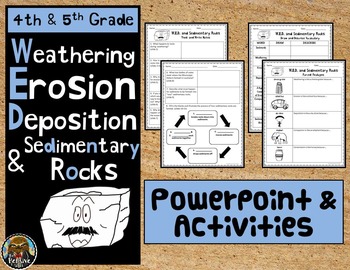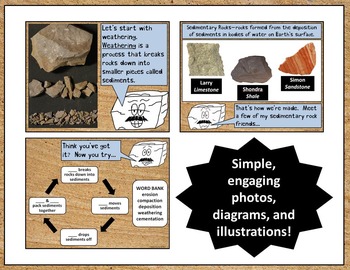Weathering, Erosion, Deposition, Sedimentary Rocks PPT and Notebook Activities
The Pensive Sloth
3k Followers
Grade Levels
4th - 5th
Subjects
Resource Type
Formats Included
- Zip
Pages
18 pages
The Pensive Sloth
3k Followers
What educators are saying
My students enjoyed working on this activity. It went well with the unit we were working on. There were no errors and it didn't take much time for me to assemble.
My students loved this resource. It was a fun way to review information that they learned. Loved the Powerpoint.
Description
#bestfansever
DESCRIPTION
If you’re trying to teach students about weathering, erosion, deposition (W.E.D.) and sedimentary rock formation in a creative way, you’ve come to the right place. Meet Steve. He’s a sedimentary rock that will tell you all about how sedimentary rocks are made. He walks you through every step of the process with simple, student friendly photos and illustrations. Plus, there are 3 activities that go with the PowerPoint slides that can be placed in student interactive notebooks. Included in this download, you get:
*An 11 slide PowerPoint presentation on sedimentary rock formation starring Sedimentary Steve that shows the processes of weathering, erosion, deposition, compaction, and cementation.
*One “Think and Write” guided notes activity (2 pages) to go with the slides (for interactive science notebooks). As the slides are presented to the class, have students stop, discuss, and write to answer the questions. This helps students to internalize new content and make it their own.
*One “Draw and Describe” vocabulary activity to go with the slides (for interactive science notebooks). After teaching the lesson, provide students a copy of the presentation (this can be printed and done during science stations). Have them use the slides to describe and draw each vocabulary word.
*One “Forced Analogies” activity where students make an analogy between an object and a new science concept (for interactive science notebooks). Coming up with analogies can make new concepts memorable for students because they are looking for similarities and differences, one of Marzano’s high-yield strategies. This strategy also helps students make connections with new material. Have students tell about a way that the concept and the image are alike.
*The download is a ZIPPED file with a PowerPoint presentation (not editable) and a PDF file with the activity pages and slides in PDF form. An answer key is also included.
*Try before you buy! Download the preview to see the entire file to make sure it meets your needs.
SUGGESTIONS FOR USING THIS PRODUCT
*Present the slides whole class, having students answer the questions on the “Think and Write” notes page. Then, have students use the presentation slides in partners or in a science station to draw and describe each vocabulary word on the chart provided. Finally, give students a chance to work in partners on the “Forced Analogies” page.
*Copy activity pages at 70% size to make them easy to add to science notebooks.
*Consider using the presentation slides and “Think and Write” notes in a flipped classroom lesson. The slides are written in engaging, student-friendly language to help students learn the new concepts easily. Class time can then be used for hands-on science lab activities.
*Make sure to provide opportunities for students to share their analogies! Students come up with interesting connections when completing forced analogies and can learn a lot from listening to their peers. This is a great strategy for gifted learners!
*For ELL students, consider providing sentence stems for the “Think and Write” notes to help get them started. The pictures in the slides provide lots of visual support of challenging science concepts.
STANDARDS
TEKS 4.7B-- Observe and identify slow changes to Earth's surface caused by weathering, erosion, and deposition from water, wind, and ice
TEKS 5.7A --Explore the processes that led to the formation of sedimentary rocks
NGSS-4th Grade ESS2.A—Earth Materials and Systems: Rainfall helps to shape the land and affects the types of living things found in a region. Water, ice, wind, living organisms, and gravity break rocks, soils, and sediments into smaller particles and move them around.
RELATED ACTIVITIES
*A daily activity to review properties of matter can be found HERE! *Looking for science vocabulary activities? These physical, Earth, and life science puzzles are self-checking and lots of fun!DISCLAIMER
As a Texas teacher, the products I make are designed around the standards for the state of Texas, known as the Texas Essential Knowledge and Skills (TEKS) and are carefully crafted to help students be successful on the Texas STAAR test. I use the challenge of the TEKS and released STAAR assessments as models to guide me when putting together lessons and materials for students. Thus, I am careful to post products that, in my judgment, address those standards. I am not affiliated in any way with these entities and any and all claims of alignment are my claims, not those of the groups behind the TEKS or STAAR test. Some of my TEKS-based products also address standards from other states, the NGSS (Next Generation Science Standards), or Common Core and related standardized tests. For these products, I include the standards in the description. I am not affiliated with these entities and any claims of alignment are mine. Please contact me if you have questions.
DESCRIPTION
If you’re trying to teach students about weathering, erosion, deposition (W.E.D.) and sedimentary rock formation in a creative way, you’ve come to the right place. Meet Steve. He’s a sedimentary rock that will tell you all about how sedimentary rocks are made. He walks you through every step of the process with simple, student friendly photos and illustrations. Plus, there are 3 activities that go with the PowerPoint slides that can be placed in student interactive notebooks. Included in this download, you get:
*An 11 slide PowerPoint presentation on sedimentary rock formation starring Sedimentary Steve that shows the processes of weathering, erosion, deposition, compaction, and cementation.
*One “Think and Write” guided notes activity (2 pages) to go with the slides (for interactive science notebooks). As the slides are presented to the class, have students stop, discuss, and write to answer the questions. This helps students to internalize new content and make it their own.
*One “Draw and Describe” vocabulary activity to go with the slides (for interactive science notebooks). After teaching the lesson, provide students a copy of the presentation (this can be printed and done during science stations). Have them use the slides to describe and draw each vocabulary word.
*One “Forced Analogies” activity where students make an analogy between an object and a new science concept (for interactive science notebooks). Coming up with analogies can make new concepts memorable for students because they are looking for similarities and differences, one of Marzano’s high-yield strategies. This strategy also helps students make connections with new material. Have students tell about a way that the concept and the image are alike.
*The download is a ZIPPED file with a PowerPoint presentation (not editable) and a PDF file with the activity pages and slides in PDF form. An answer key is also included.
*Try before you buy! Download the preview to see the entire file to make sure it meets your needs.
SUGGESTIONS FOR USING THIS PRODUCT
*Present the slides whole class, having students answer the questions on the “Think and Write” notes page. Then, have students use the presentation slides in partners or in a science station to draw and describe each vocabulary word on the chart provided. Finally, give students a chance to work in partners on the “Forced Analogies” page.
*Copy activity pages at 70% size to make them easy to add to science notebooks.
*Consider using the presentation slides and “Think and Write” notes in a flipped classroom lesson. The slides are written in engaging, student-friendly language to help students learn the new concepts easily. Class time can then be used for hands-on science lab activities.
*Make sure to provide opportunities for students to share their analogies! Students come up with interesting connections when completing forced analogies and can learn a lot from listening to their peers. This is a great strategy for gifted learners!
*For ELL students, consider providing sentence stems for the “Think and Write” notes to help get them started. The pictures in the slides provide lots of visual support of challenging science concepts.
STANDARDS
TEKS 4.7B-- Observe and identify slow changes to Earth's surface caused by weathering, erosion, and deposition from water, wind, and ice
TEKS 5.7A --Explore the processes that led to the formation of sedimentary rocks
NGSS-4th Grade ESS2.A—Earth Materials and Systems: Rainfall helps to shape the land and affects the types of living things found in a region. Water, ice, wind, living organisms, and gravity break rocks, soils, and sediments into smaller particles and move them around.
RELATED ACTIVITIES
*A daily activity to review properties of matter can be found HERE! *Looking for science vocabulary activities? These physical, Earth, and life science puzzles are self-checking and lots of fun!DISCLAIMER
As a Texas teacher, the products I make are designed around the standards for the state of Texas, known as the Texas Essential Knowledge and Skills (TEKS) and are carefully crafted to help students be successful on the Texas STAAR test. I use the challenge of the TEKS and released STAAR assessments as models to guide me when putting together lessons and materials for students. Thus, I am careful to post products that, in my judgment, address those standards. I am not affiliated in any way with these entities and any and all claims of alignment are my claims, not those of the groups behind the TEKS or STAAR test. Some of my TEKS-based products also address standards from other states, the NGSS (Next Generation Science Standards), or Common Core and related standardized tests. For these products, I include the standards in the description. I am not affiliated with these entities and any claims of alignment are mine. Please contact me if you have questions.
Total Pages
18 pages
Answer Key
Included
Teaching Duration
3 hours
Report this resource to TPT
Reported resources will be reviewed by our team. Report this resource to let us know if this resource violates TPT’s content guidelines.





